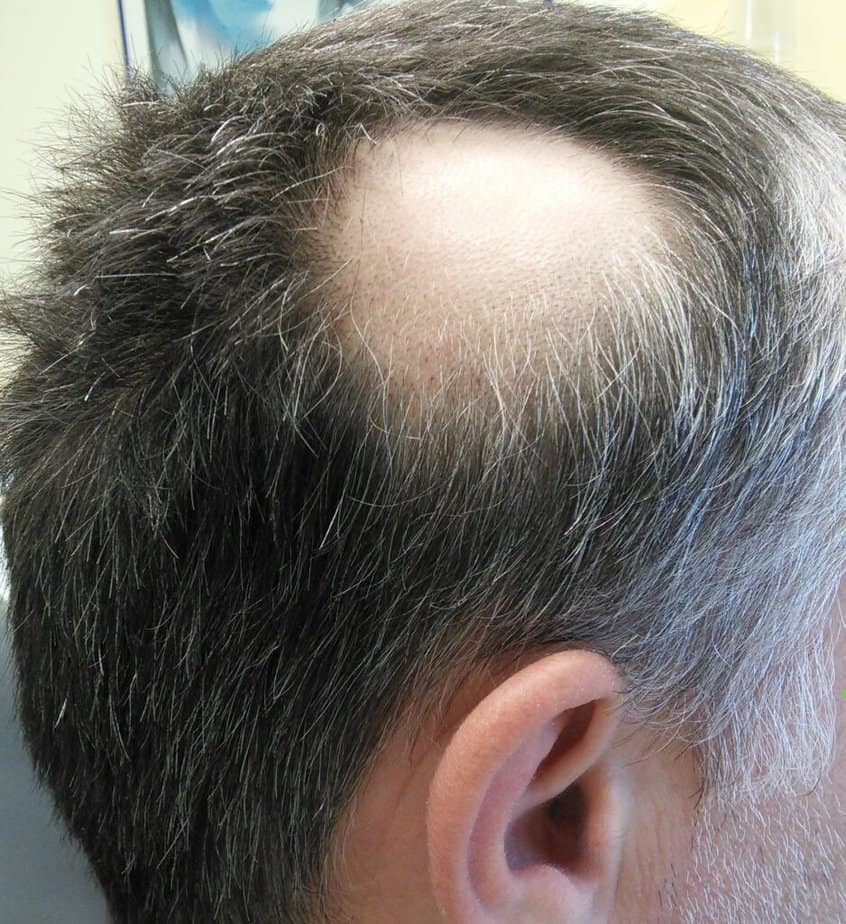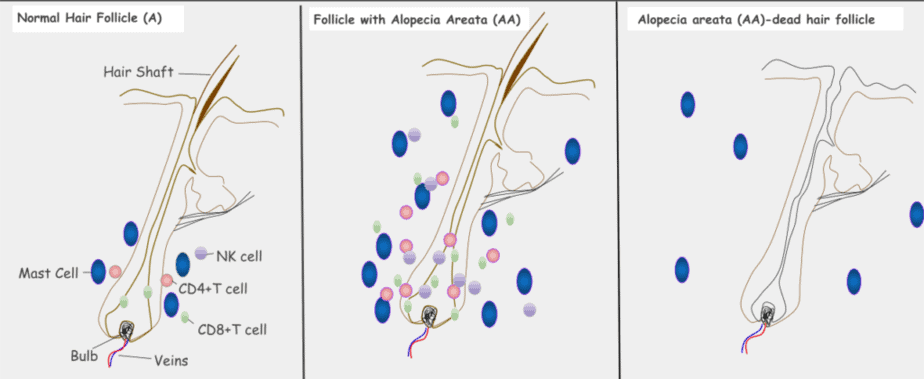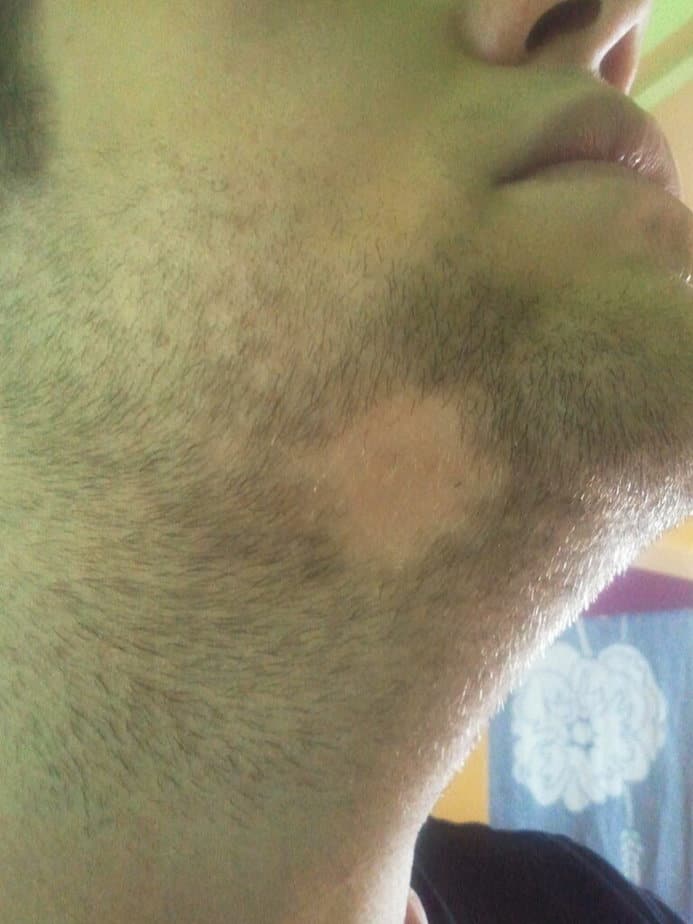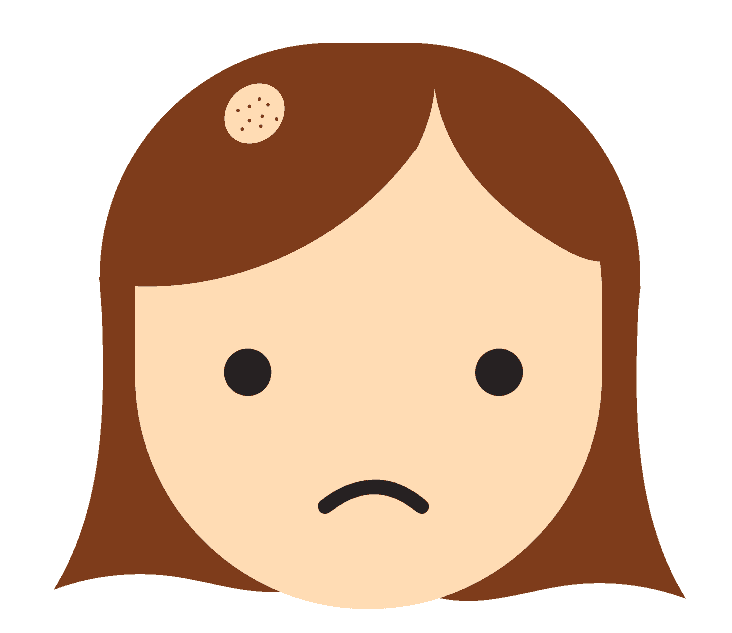Table of contents
Nebula Genomics DNA Report for Alopecia
Is alopecia genetic? We created a DNA report based on a study that attempted to answer this question. Below you can see a SAMPLE DNA report. To get your personalized DNA report, purchase our Whole Genome Sequencing!

What is Alopecia?
Alopecia is the general scientific term for hair loss when there is no underlying cause such as a skin disease or other internal disorder. The condition affects both men and women, can occur on any part of the body (although it’s most common on the head), and can be either temporary or permanent.
Genetics, hormone changes, medications, and aging may all play a role in hair loss. Baldness on the scalp is much more common with advanced age and is more common in men than women. Doctors can make a diagnosis based on where and how the hair is being lost.
While a number of people choose not to treat this condition, many others do. Patients can use cosmetic changes, medications, and even hair transplants to reduce hair loss, if desired. If alopecia is caused by an autoimmune disorder, they may find steroid treatments effective.
There are three types of the autoimmune disorder that causes hair loss, characterized by how severe the loss appears. They are called alopecia areata, alopecia totalis, and alopecia universalis.

Types
There are three types of alopecia areata:
- Alopecia areata: a common autoimmune disorder, this form causes hair to fall out in small patches.
- Alopecia totalis: An advanced form of alopecia areata, this form of hair loss causes complete loss of scalp hair.
- Alopecia universalis: An advanced form of alopecia areata, this form causes complete loss of hair from the scalp and body.
Is Alopecia Genetic?
Scientists believe environmental factors and genetics cause alopecia areata. Doctors expect it to be hereditary as they observe the risk of developing the condition is greater if a person has a first degree relative with it. However, genetic alopecia is known to be a complex disease in which many genes are involved and is not well understood.

Most of the genetic basis of alopecia areata involves genes identified with the condition play a role in the immune system and several of these genes are part of the human leukocyte antigen (HLA) complex. This complex contributes to the immune system’s ability to distinguish between proteins made by the body and those made from foreign invaders. When genetic variants prevent the complex from doing its job, the body has a greater risk of attacking its own cells.
People with alopecia areata also tend to have family members with other autoimmune disorders:
- Vitiligo
- Systemic lupus erythematosus
- Atopic dermatitis
- Allergic asthma
- Autoimmune thyroid diseases (Hashimoto thyroiditis and Graves disease)
- Addison’s disease
Epidemiology
Worldwide, 100-200 of every 100,000 people develop alopecia areata with a lifetime risk of 2%. Alopecia areata affects an estimate of millions of people in the United States.
Out of these millions of Americans, the condition occurs in both adults and childrens and this specific condition appears to affect both males and females of all ethnicities equally. It occurs most often in children and young adults over a period of weeks. It can be an unpredictable disease in that the hair will grow back in most cases but it may fall out again without warning.
The mean age of diagnosis was 32 years in males and 36 years in females.
Symptoms
Usually, the first and only sign of alopecia areata is the sudden loss of hair. This hair loss normally occurs on the scalp as a round or oval bald patch. Generally, hair falls out in small round patches. The patches can continue to grow and form one large patch.
Although the scalp is most common, it can also occur with other body hair and in other patterns:
- Men may experience round patches of hair loss in the beard area
- While round patches are the most common, there can be other patterns of hair loss
- Some people develop a band of hair loss on their scalp
- Widespread hair loss is possible
- Loss of eyelashes and eyebrows is possible
- Red nails or brittle nails (this is more common in alopecia universalis)

Other than hair loss, there is no pain or other symptoms of alopecia. Some people report a tingling or itching in the area where the hair will fall out before it actually occurs.
For some people, the greatest risk factor to general health is the psychological impact of the disease and low self esteem. Doctors often associate the condition with depression, anxiety, and other mental health disorders.
Causes
Alopecia areata is an autoimmune disease that occurs when your immune system mistakenly attacks the hair follicles in your body. Although the attack will cause hair loss, it does not destroy the follicles. This means that your hair will grow back once the immune reaction subsides.
Cold may be a trigger of the condition as more people report being diagnosed in November and other colder months while the fewest reported cases were in May and August. Other triggers that can increase risk are stress and physical injury.
Some patients with other autoimmune diseases, such as multiple sclerosis and rheumatoid arthritis, also have a vitamin D deficiency. This has prompted research into vitamin D levels in relation to patients with alopecia areata. As of this article, results tend to be inconclusive with some patients showing an association while others do not.
Those with disorders such as type 1 diabetes are also at higher risk.
Non-immune causes
A number of factors may cause hair loss unrelated to the autoimmune disease. Family history in which hair loss occurs with aging is the most common cause of baldness. This usually occurs in a predictable pattern in the form of male pattern baldness or female pattern baldness, also called androgenetic alopecia. Doctors have associated physical and emotional shock great enough to cause a large amount of stress with thinning hair although this hair loss is normally temporary.
Hormonal changes such as pregnancy, childbirth, or thyroid conditions can also cause either permanent or temporary hair loss. In addition to alopecia areata, other medical conditions such as infections caused by ringworm and trichotillomania (a hair pulling disorder) can cause unexpected hair loss.
Hair loss can be a side effect of certain medications and medical treatment. These include medications for cancer, arthritis, depression, heart problems, gout, and high blood pressure as well as radiation therapy traditionally used to treat forms of cancer.
Diagnosis
To diagnose the condition, your doctor will probably recommend a physical exam and look at the pattern and amount of hair that is lost. They can use additional procedures to diagnose underlying health conditions that may be causing hair loss.

If your doctor suspects an underlying condition, they may recommend a blood test, which can reveal autoimmune disorders like alopecia areata, a scalp biopsy, which can help detect infractions, or light microscopy (examination of the hair on a microscope). The type of test your doctor recommends is largely based on what they may suspect is causing the problem, which may be based on other symptoms.
If the cause cannot be determined, your doctor may recommend a specialist called a dermatologist, who focuses on hair and skin.
Treating Genetic and Non-genetic Alopecia
Some people choose not to treat hair loss and instead let it fall out naturally or shave their heads. In many cases of alopecia areata, the hair will grow back naturally over time and thus doctors do not recommend treatment at points of less than a year. Although there is no cure for alopecia areata, people may be able to find treatments that stop or slow the condition.
Treatment will largely depend on age as well as extent and location of hair loss.
Treatments for children 10 years and younger
This condition often starts in early childhood. Hair loss and regrowth can be particularly hard emotionally at this age.
For these children, corticosteroids applied to the bald spots are usually the first option. An adult applies this medication 1-2 times per day and it helps regrow hair. It is normally very effective.
Once corticosteroids are stopped, doctors may replace them with another medication called minoxidil which helps maintain hair growth. These medications have few side effects, making them ideal for young patients.
Patchy hair loss
In the case of a few bald spots in patients 10 years and older, doctors may use similar medications. This is the most common cause for genetic alopecia. Generally, they recommend corticosteroid injections into the bald spots. They perform this treatment at a dermatologist’s office every 4 to 8 weeks and consider it the most effective treatment.
Adults
As with children, doctors may give you minoxidil to help maintain growth. Other topical options are topical corticosteroids and another prescription called anthralin, which may cause skin irritation.
Loss of other hair
If hair in other areas of the body besides scalp hair loss occurs, your doctor may recommend some cosmetic or prescription treatments to keep your body healthy. For example, eyelashes help protect your eyes. If you lose your eyelashes due to this condition, your doctor may prescribe false eyelashes, glasses, or a medication called bimatoprost (typically prescribed to treat glaucoma) to help regrow eyelashes.
Eyebrows can also be important for self-esteem. Doctors can treat loss of eyebrows with fake eyebrows, semi-permanent tattoos, or medication that stimulates their regrowth, such as corticosteroids.
Alopecia totalis and alopecia universalis
These subtypes of the condition involve losing lots of hair very quickly from most or all of the body. In these cases, hair regrowth on its own is rare. Your doctor or dermatologist may recommend the following options to improve quality of life if hair loss causes anxiety and self esteem problems:
Contact immunotherapy: This process involves a doctor applying chemicals to the bald areas of your head on a regular basis. Experts designed this treatment to stop the immune response from attacking the hair follicles in this region. Doctors give it weekly to remain in the affected areas for 48 hours.
A rash is expected to occur as it signals that the medication is working. Treatment continues until hair is regrown or it fails to regrow in 6 months.
Methotrexate: This medication is designed to prevent the immune system from reacting and is often used to treat rheumatoid arthritis. It has seen some success, especially when combined with corticosteroid treatment. This medication sometimes has serious side effects so it’s important to consult with a health care professional for medical advice.
JAK inhibitors: This new type of medication often works for patients when other treatments have failed. It has been shown that regrown hair will fall out if the medication is stopped. Therefore, other variations of this drug are being studied. This treatment was first found to have success in clinical trials at the Irving Medical Center at Columbia University.
This Is alopecia genetic article is for educational purposes only. It’s important to remember that for those with only a few patches of missing hair, it tends to grow back within one year. For others, treatments are available with the help of a medical professional.
More information
More information on symptoms, treatment options, and clinical trials can be found at the National Institute of Arthritis and Musculoskeletal and Skin Diseases website and the U.S. National Library of Medicine.
You may also be interested in the National Alopecia Areata Foundation website.
If you liked this article, you should check out our other posts in the Nebula Research Library!
You may also be interested in these company reviews that offer products to stop or reduce hair loss:
- Capillus (laser filled caps to stimulate hair follicles)
- Keeps (prescription strength hair loss treatment)
- Nutrafol (supplements for hair growth and thickening)
- Vegamour (plant-based hair care products)
- Viviscal (supplements for hair growth and thickening)
December 20, 2022
